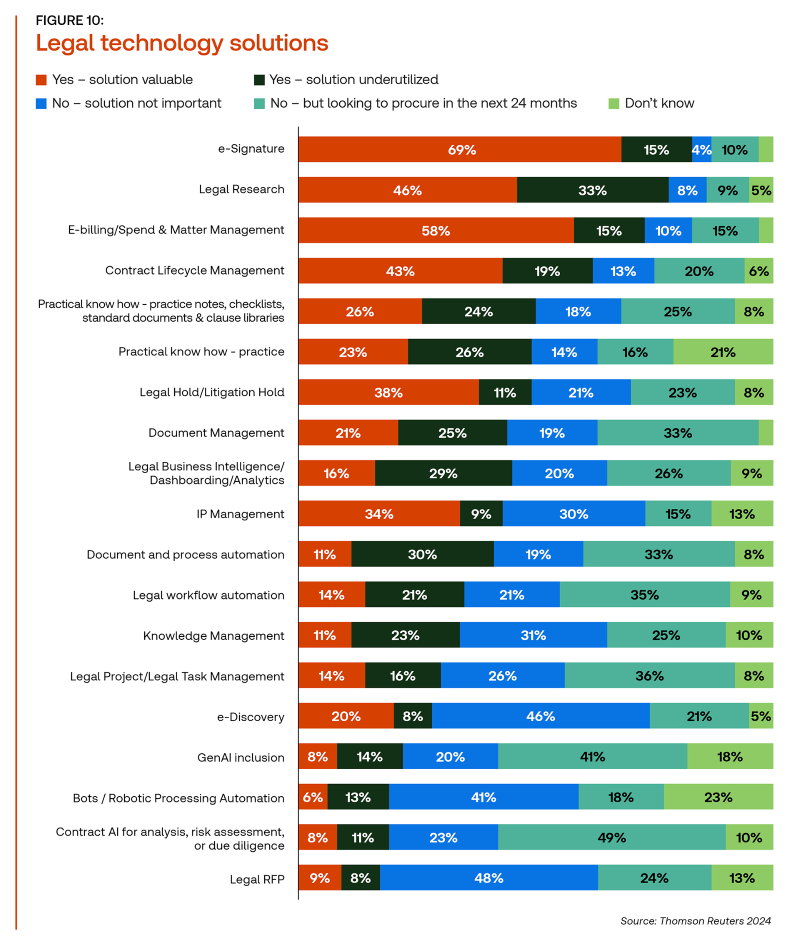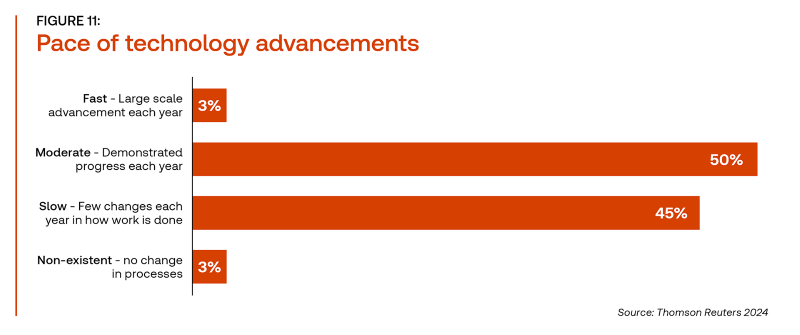While many legal departments are adopting next-generation technologies, many others find the tech more underutilized than valuable, a recent report found
It’s clear that corporate legal departments’ use of legal technology tools has increased in recent years. Indeed, 63% of respondents said their department’s use of legal tech tools is increasing, while just 2% said their department’s tech use is decreasing, according to the Thomson Reuters Institute’s 2024 Legal Department Operations Index report (LDO Index).
Given the rise of the legal operations discipline as a whole and a general move towards in-sourcing work, this trend may be unsurprising. However, at the same time, it’s clear that law departments do not regard all legal tech tools the same way.
Digging deeper into their use of various tech tools, the report found that some of the more common tools such as e-signature, e-spend & billing management, and legal research software are not only present but are widely utilized throughout the organization. Some newer categories of tools, however, are struggling to achieve widespread utilization, leading to less adequate return on investment (ROI) for many new technologies.
Particularly with the introduction of new foundational (and potentially expensive) technology like generative artificial intelligence (GenAI), legal departments will increasingly need to be focused not only on initial technology adoption but maximizing ongoing technology utilization. And for legal operations professionals, the answer may be in how they find and explain the practical value of new software to a constituency accustomed to their traditional, tried-and-true tech.
A place for new technologies
Today’s corporate law departments use a wide variety of tools, covering the practice of law, internal business and knowledge management, and interaction with other internal company stakeholders. In fact, the LDO Index measured 11 different categories of technologies, ranging from e-signature software to document and process automation, that are in use at more than 40% of legal departments. There are also a number of other types of technologies, particularly those involving AI, that are expected to see large jumps in use within the next 24 months.
But not all technologies are created — and used — equally. The LDO Index also asked respondents whether those technologies they have within their department already are valuable or underutilized. Some technologies — particularly those dealing with the practice of law such as e-signature, e-billing and contract lifecycle management — were seen as largely valuable. However, many tools that are not for direct client work or are used more for back-office purposes — such as legal business intelligence, document and process automation, and knowledge management — had more respondents saying these tools were underutilized rather than valuable.

This trend also was present for technologies that have only recently been introduced to the marketplace. While 22% of respondents said their legal departments had included GenAI into their technology stack, for example, just 8% called it valuable, while 14% said it was underutilized. Bots/robotic processing automation and contract-related AI were similarly categorized as more underutilized than valuable.
It could be that respondents don’t see these and other new technologies as having a place in the modern legal department, or simply that they haven’t not yet experienced the value these tools are expected to bring. However, given the fact that many departments are still looking to purchase these tools, it’s likely that department leaders do see some value here.
A more likely answer is that those within corporate legal departments are still working to catch up to new technologies. When asked about the pace of technological advancements within their departments, very few respondents called their organizations fast — meaning large-scale advancement each year. Most see their departments as either having moderate or slow technological advancement on average.

This may have worked during the previous pace of technological change; now, however, new technologies are becoming available to the corporate world at a rapid pace. Take GenAI for example: ChatGPT became publicly available just two years ago in November 2022, but already, more than half of corporate legal professionals have said they believe it can and should be used for legal work.
For legal departments that want to get the most out of their technology investment, their overall pace of technology utilization will need to catch up with technology advancement itself. Otherwise, legal departments will be stuck looking to invest in new technologies while still not gleaning the most out of the newer technologies they have already recently adopted.
The question then becomes how operations professionals can encourage their legal departments to prioritize their underutilized tools. The answer comes with proving new tools’ value, and that proof comes by using new ways of measuring success.
Finding the value in tech
According to the LDO Index, 71% of respondents said their legal departments are increasing their spend on legal technology and more than one-third of respondents said their departments have increased their legal tech spend by more than 10% within the past year. Given this, it’s reasonable that many departments will want to see a direct ROI in new technologies in order to prove their value.
However, legal department operations professionals should recognize that the benefits of many technology tools will be varied, and often realized over time rather than immediately. Pure year-over-year ROI will likely not give the true reflection of the value of new technology.
“We expect that it will take time to fully understand for which workflows our GenAI tools can be deployed and the efficiencies gained from the use of those tools,” said one survey respondent. “Therefore, the percentage savings will be modest initially and grow over time.”
This is where legal operations professionals can have a distinct role in measuring the true value of technology. Indeed, they should take the lead on not only defining what success looks like, but in developing measurements for that success and making sure those metrics are collected throughout the tool’s lifecycle.
Take for example those tools that are determined to be underutilized. Operations professionals should not only collect technology usage and general satisfaction data, but expand upon those data points to get next-level insights, including:
-
-
- Is the underutilization a matter of unavailability of the tool, unfamiliarity with the tool, or the utility of the tool itself?
- How has tool usage changed since initial adoption, and if there is fall off, where or when does it occur?
- Is the department’s level of technology investment in line with both modern standards and the short- and long-term goals of the department?
- And crucially, is there a way to reverse the underutilization trend for technologies that operations professionals see as useful, but attorneys and other staff may not?
-
As the LDO Index makes clear, legal operations professionals can play a pivotal role in interpreting why a technology has the reception that it does, and in doing so, prove their own value to the organization. Modern operations leaders need to not only track technology patterns but gain insights that can help make strategic decisions for the department at large.
Technology as a key decision point is not going away, and the pace of technological change is not slowing down. The time is now for legal operations professionals to begin gaining more utilization out of newer and back-office technologies — and the way to start is through gaining more insight into why underutilization occurs in the department in the first place.
You can download a full copy of the Thomson Reuters Institute’s 2024 Legal Department Operations Index here.







